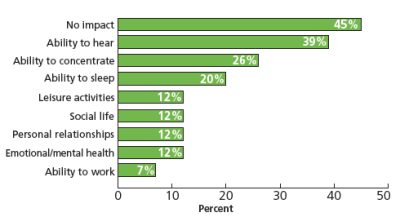OUR TRAINING
The program consists of personalized sound exercises, with causal stimuli to ensure that the training is every day, and for the entire duration of the training, always different.
The bases on which our training is based are described in the following article.
TREATMENT OF ACUFENI: THE INNOVATIVE SOUND THERAPY
Epidemiology
Tinnitus is represented as a sound sensation, perceived in one or both ears or, more generally, inside the head in the absence of a sound source.
Epidemiological data show that up to 18% of the population, in industrialized countries, has chronic tinnitus (perception greater than six months) and in 1% of cases this leads to a serious alteration in the quality of life1.
In Italy, tinnitus affects over 3 million adults and is perceived as a major problem by more than 600,000 Italians, most of them over 45 years old2.
In the UK it affects 16% of adults aged between 40 and 69, and about 30% of adults over 75 years for a total of almost six million people3, 4, 5.

Fig. 1 MarkeTrak VIII: The Prevalence of Tinnitus in the United States and the Self-reported Efficacy of Various Treatments. Sergei Kochkin, PhD, Richard Tyler, PhD, Jennifer Born 2011
In the United States more than 50 million people complain of tinnitus (from 10% to 15% of the adult population) 6. According to a study by S Kochkin and R. Tyler (Marke Trak VIII: The prevalence of tinnitus in the United States and the self-reported efficacy of various treatments - 2011), tinnitus in the United States affects 21% of the population beyond 45 years of age, with peaks of 26% over 65 years. According to the same study, over 55% of this population has an alteration in quality of life with difficulty concentrating (26%), insomnia (20%), social relationships (12%) and difficulties at work (7%). In 39% of this population there is a reduced hearing ability (fig. 1).
A review of the literature7 that involved over 64 clinical studies showed that tinnitus is often associated with depression (28%), sleep disorders (24%), anxiety (22%) and alcohol dependence (16%). In many of these patients there is an association of the different symptoms.
Therapy
The problem of tinnitus therapy is still open today. There are no single therapies in the common sense of the term, ie there are no drugs of proven efficacy in attenuating or abolishing tinnitus in a significant number of cases.
A milestone in the treatment of tinnitus was the discovery of the need to individualize care according to the different needs of each individual patient8. In more recent years, scientific research and imaging have shown that tinnitus can be the result of abnormal interactions between neural circuits that affect the auditory areas. The processes of reorganization in the auditory cortex after sensorineural deafness, even of slight magnitude, have the task of maintaining the cortical specular tonotopicity representing the cochlear one. From this research it emerges that the mechanisms underlying the onset of tinnitus can be a direct consequence of an anomalous neural plasticity able to reorganize following peripheral (cochlear) damage 9 - 10. Different works have shown that exercises of personalized auditory training, reduce the impact of these changes from abnormal reorganization 10-11 - 12.
Conditional Acoustic Neuromodulation (NAC) is an innovative sound therapy, based on the most recent knowledge of brain plasticity and conditional listening. The objective of the NAC is to train the brain through external acoustic signals designed to determine a correct cortical reorganization in order to reduce or block the tinnitogenic substrate responsible for the onset and perception of tinnitus. If the frequency of sound signals is similar but not superimposable to that of tinnitus, the trained auditory cortex (Auditory Perceptual Training) enters into competition with the areas stimulated by the constant presence of tinnitus, subtracting from this the pathological substrate (Cortical Re- Mapping).
1. SAVAGE J. *, ADDELL A. °, * Southmead Hospital, Bristol, United Kingdom; ° Great Western Hospital, Swindon, United Kingdom. TINNITUS: Clinical Evidence Handbook a publication of bmj publishing group. 2014
2. Gallus S. *, Lugo A., Garavello W., Bosetti C., Langguth B. et Al. * Department of Epidemiology, IRCCS - Institute of Pharmacological Research "Mario Negri", Milan, Italy. Prevalence and Determinants of Tinnitus in the Italian Adult Population. Neuroepidemiology. 2015; 45 (1): 12-9
3. Abby McCormack, Mark Edmondson-Jones, Duane Mellor, Piers Dawes, Kevin J. Munro, David R. Moore, Heather Fortnum. NIHR Nottingham Hearing Biomedical Research Unit, Ropewalk House, 113 The Ropewalk, Nottingham, United Kingdom. Otology and Hearing group, Division of Clinical Neuroscience, School of Medicine, University of Nottingham, Nottingham, United Kingdom. MRC Institute of Hearing Research, University Park, Nottingham, United Kingdom. School of Biosciences, University of Nottingham, Nottingham, United Kingdom. School of Psychological Sciences, University of Manchester, Manchester, United Kingdom. Cincinnati, Ohio, United States of America. Association of Dietary Factors with Presence and Severity of Tinnitus in a Middle-Aged UK Population. PLoS One. 2014 Dec 12; 9 (12): pubmed
4. McCormack A, Edmondson-Jones M, Fortnum H, Dawes P, Middleton H, et al. The prevalence of tinnitus and the relationship with neuroticism in a middle-aged UK population. The Journal of Psychosomatic Research. 2014 76 (1): 5 pubmed
5. Dawes P, Fortnum H, Moore DR, Emsley R, Norman P, et al. Middle Age Hearing: A Population Snapshot of 40-to-69-Year Olds in the United Kingdom. Ear and Hearing 2014 pubmed
6. Tunkel DE, Bauer CA, Sun GH, Rosenfeld RM, Chandrasekhar SS, Cunningham ER Jr, Archer SM, Blakley BW, Carter JM, Granieri EC10, Henry JA, Hollingsworth D, Khan FA, Mitchell S, Monfared A, Newman CW , Omole FS, Phillips CD, Robinson SK, Taw MB, Tyler RS, Waguespack R, Whamond EJ. Clinical practice guideline: tinnitus.
Otolaryngol Head Neck Surg. 2014 Oct; 151 (2 Suppl): S1-S4.
7. Geocze L, Mucci S, Abranches DC, Marco MA, Penido Nde O. Systematic review on the evidence of an association between tinnitus and depression. Braz J Otorhinolaryngol. 2013 Jan-Feb; 79 (1): 106-11.
8. Henry JA, Schechter MA, Zaugg TL, Griest S, Jastreboff PJ, Vernon JA, Kaelin C, Meikle MB, Lyons KS, Stewart BJ. Clinical trial to compare tinnitus masking and tinnitus retraining therapy. Acta Otolaryngol Suppl. 2006 Dec; (556): 64-9.
9. Weisz N1, Wienbruch C, Dohrmann K, Elbert T. Neuromagnetic indicators of auditory cortical reorganization of tinnitus. Brain. 2005 Nov; 128 (Pt 11): 2722-31.Jul 13.
10. Pineda JA1, Moore FR, Viirre E. Tinnitus treatment with customized sounds. International Tinnitus Journal 2008; 14 (1): 17-25.
11. Herraiz C, Diges I, Cobo P, Aparicio JM. Cortical reorganization and tinnitus: principles of auditory discrimination training for tinnitus management. Eur Arch Otorhinolaryngol. 2009 Jan; 266 (1): 9-16.
12. Hoare DJ, Stacey PC, Hall DA. The efficacy of auditory perceptual training for tinnitus: a systematic review. Ann Behav Med. 2010 Dec; 40 (3): 313-24.
13. Hoare DJ, Adjamian P, Sereda M, Hall DA. Recent technological advances in sound-based approaches to tinnitus treatment: a review of efficacy considered against putative physiological mechanisms. Noise Health. 2013; 15: 107-116.
14. Hoare DJ, Searchfield GD, El Refaie A, Henry JA. Sound therapy for tinnitus management: practicable options. J Am Acad Audiol. 2014 Jan; 25 (1): 62-75











